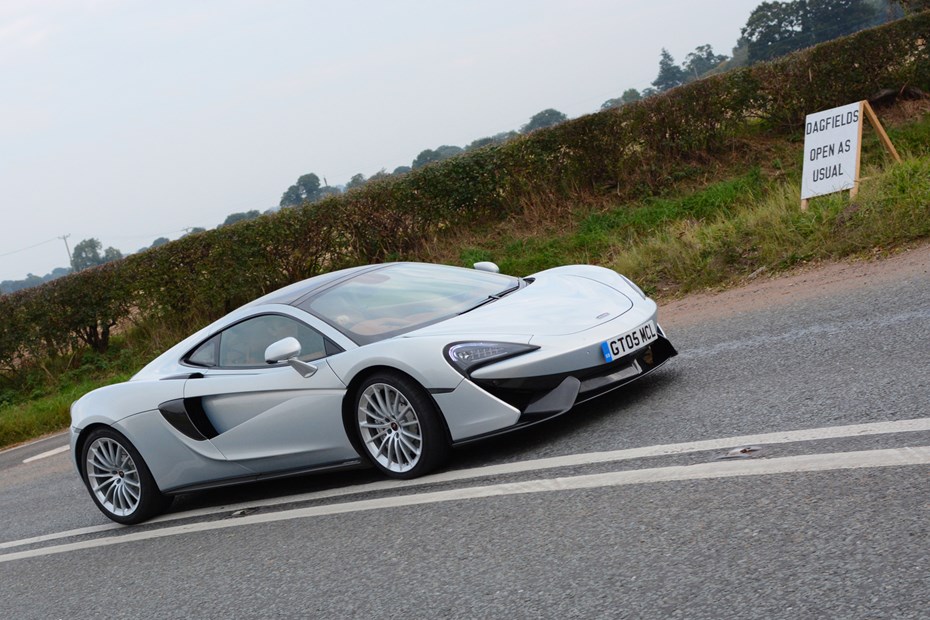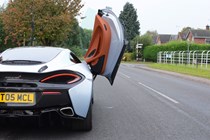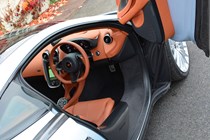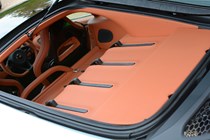McLaren 570GT Coupe (2016-2019) engines, drive and performance

- Top speed in excess of 200mph
- Requires plenty of revs for best performance
- Seamless-shift gearbox feels wonderful
Cast aside concerns about the McLaren 570GT’s softer nature sanitising the performance on offer – this is one blisteringly quick coupe.
Supercar levels of performance
Shoehorned under the Touring Deck boot space is a McLaren-developed 3.8-litre V8 engine, mounted in the middle of the car (between the front and rear axles) and sending its considerable power exclusively to the rear wheels.
In today’s power-hungry era, a large engine is no longer enough to generate the kind of urgency buyers expect, hence the 570GT packs a pair of turbochargers. Their high-pitched whooshing adds to the driving experience, with the roar of the V8 gathering momentum to do its best to drown out the turbines as the revs climb.
On occasion, particularly with the gearbox left to its own devices in automatic mode, there’s a noticeable degree of turbo lag – where the performance doesn’t come on song quite as quickly as your right foot demands – but it’s soon forgotten as you scorch towards the horizon.
Peak power is rated at 570hp requiring the rev counter to arc all the way over to 7,500rpm before the maximum’s extracted from it, something it does willingly – it’s a very flexible unit. There’s also 600Nm of torque available, again the full force of which comes on stream at a very revvy 5,000rpm.
These translate into a top speed of 204mph and a 0-62mph time of just 3.4 seconds. The 570GT will reach 100mph from a standstill in just 6.6 seconds – it’s certainly no slouch, although with a quieter exhaust than its 570S Coupe sibling, it certainly sounds less frenzied.
Delightful automatic gearbox
Even more engaging than the engine is McLaren’s seven-speed seamless-shift gearbox (SSG) – a twin-clutch automatic. Manuals have fallen out of favour with supercar buyers over recent years and it gives McLaren’s car-building arm a further reference point to its Formula 1 operations, where semi-automatic transmissions have been the norm for a quarter of a century.
It’s impressively smooth in automatic mode, making incredibly light work of the stop-start urban trudge that will inevitably form part of its routine, but on longer expanses of road the gearchanges are astonishingly quick, the accumulation of speed relentless.
Manual changes can be actioned via the steering column paddles, or more accurately paddle in the singular. It’s a single piece of carbonfibre that’s mounted immediately behind the steering wheel, so as you pull it closer to you with your right hand for an up-change, the left-side of the paddle pushes away from your fingers. It feels unusual at first but your hands soon become acclimatised to it.
- Well-balanced, adjustable handling
- Remarkably comfortable too
- Steering and suspension softer than 570S
Once you’ve poured yourself into the McLaren 570GT’s snug-yet-comfortable cabin, you immediately feel at one with the car, with the controls positioned perfectly at your hands and feet to exploit its handling prowess.
In producing the 570GT from the 570S it’s based on, McLaren’s softened its responses to make it more compliant and easier to live with as you cross continents with eye-widening speed.
Take the suspension: the front springs are 15 percent softer in the GT, while the rear pair are 10 percent more compliant – the comfort can be further enhanced by leaving the adaptive suspension in its default Normal setting (Sport and Track are your firmer and firmest options, respectively). Sport is noticeably firmer and could prove tiresome on all but the smoothest of surfaces after a while, while Track is best reserved for circuit driving.
Worry not, though: the 570GT changes direction without feeling remotely like composure’s on the brink of being lost and bodyroll itself is negligible. It’s a remarkable feat how the McLaren manages to feel so supple yet taut enough to enjoy its performance.
It’s a similar story with the steering which has been made two percent less direct compared with the 570S’s arrangement in order to smooth out those miniscule corrections you will inevitably make on motorway runs, preventing you from darting out of your lane at the slightest movement of the wheel.
Yet it offers a clarity of feedback that delights your senses to the same degree it informs them of what the front wheels are up to, weighting up with finesse as the degree of lock is ramped up. If we’re nit-picking it’s a little lighter than we’d like in a straight-ahead position but inevitably a heavier steering rack would become tiresome on the long jaunts the 570GT’s designed to undertake.
Everything about the way the McLaren responds to your inputs feels deliciously satisfying – it’s such an easy car to drive very quickly yet has reserves of fun to exploit the more you press on.





























